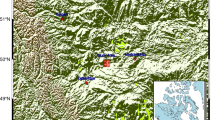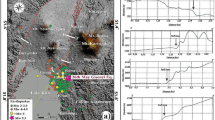Abstract
The problem of seismic imaging in complex structures such as folded faulting areas, salt domes, or mud volcano-bearing areas cannot be properly solved by the conventional seismic processing methods. The reverse time migration, Gaussian beam migration, the extended search strategy in the optimized common reflection surface (CRS) stack, and the partial CRS stack methods are among the new methods introduced for seismic imaging in complex structures. Among them, the CRS stack method is frequently used for seismic imaging. However, besides its great advantage in enhancing the quality of seismic section, it faces with some problem in imaging of complex structures, especially in the existence of conflicting dips. The CRS method transforms pre-processed multi-coverage data into a zero-offset section by summing along stacking surfaces instead of only along a common reflection point trajectory. The extended parameter search strategy in the CRS method and the partial CRS stack method were introduced to solve the problem of conflicting dips in the CRS method. However, some examples showed that these methods could not completely solve the problem of conflicting dips. In this study, a new introduced method is used to completely solve the problem of conflicting dips in complex structures. The new stacking surface is the approximation of diffraction response of a diffraction point. The surface is made by well-known three CRS attributes, where the radius of normal and normal incidence point waves is equals. The third parameter is the emergence angle of the central ray that the stacking surface is built for each angle, thus making an operator volume. Therefore, the operator gathers more energy that might get lost by other stacking surfaces. The new method was applied on a seismic data from a complex geological structure from northeast of Iran. This area contains mud volcano, an indicator for gas reservoir. Mud also absorbs the seismic energy and deteriorates the quality of the seismic section. Therefore, imaging the boundary of the mud volcano is questionable. By applying post-stack time migration on the stacked section obtained by the new method, the advantage of the stacking operator has been evaluated for imaging in complex structures. These advantages were more highlighted in depth migration applied on the new introduced operator volume common diffraction surface (CDS)-stacked section. The results showed that not only the boundary of the mud but also the faults that were completely unclear in previous results were imaged well.
















Similar content being viewed by others
References
Alaei B (2006) An integrated procedure for migration velocity analysis in complex structures of thrust belts. J Appl Geophys 59:89–105
Baykulov M (2009) Seismic imaging in complex media with the Common Reflection Surface stack. Ph. D Thesis, Hamburg University
Baykulov M, Gajewski D (2009) Prestack seismic data enhancement with partial common-reflection-surface (CRS) stack. Geophysics 74:49–58
Baykulov M, Dummong S, Gajewski D (2011) From time to depth with CRS attributes. Geophysics 76:151–155
Baysal E, Kosloff DD, Sherwood JWC (1983) Reverse time migration. Geophysics 48:1514–1524
Berkovitch A, Belfer I, Landa E (2008) Multifocusing as a method of improving subsurface imaging. Lead Edge 27:250–256. doi:10.1190/1.2840374
Biondi B (2006) 3D Seismic Imaging. Investigations in Geophysics. 14, SEG, Tulsa
Bishop TN, Bube KP, Cutler RT, Langan RT, Love PL, Resnick JR, Shrey RT, Spindler DA, Wyld HW (1985) Tomographic determination of velocity and depth in laterally varying media. Geophysics 50:903–923
de Bazelaire E (1986) Normal moveout revisited—inhomogeneous media and curved interfaces: 56th Annual Internat. Mtg., Soc. Expl. Geophys. Expanded Abstracts, Session: POS2.4
de Bazelaire E (1988) Normal moveout revisited—inhomogeneous media and curved interfaces. Geophysics 53:143–157
de Bazelaire E, Thore P (1987) Pattern recognition applied to time and velocity contours. 57th Annual Internat. Mtg., Soc. Expl. Geophys., Expanded Abstracts, Session: POS2.14
Dong L, Zhenchun L, Xiaodong S, Ning Q, and Xuefeng Z (2010) Prestack Seismic Data Enhancement with the Common-Offset Common Reflection Surface (CO CRS) Stack. 3rd International Conference on Biomedical Engineering and Informatics, BMEI
Duveneck E (2004) Velocity model estimation with data-derived wavefront attributes. Geophysics 69:265–274. doi:10.1190/1.1649394
Faye JP, Jeannot JP (1986) Pre-stack migration velocities from focusing depth analysis. 56th Ann. Internat. Mtg., Soc. Expl. Geophys. Expanded abstract, 438–440
Garabito G, Oliva PC, Cruz JCR (2011) Numerical analysis of the finite-offset common-reflection-surface traveltime approximations. J Appl Geophys 74:89–99
Garabito G, Stoffa PL, Ferreira CASC, Cruz JCR (2012) Part II—CRS-beam PSDM: Kirchhoff-beam prestack depth migration using the 2D CRS stacking operator. J Appl Geophys 85:102–110
Gray S, Zhou H, Pham D (2004) A strategy for using several reflection tomography methods in combination. Estimation of Accurate Velocity Macro Models in Complex Structures EAGE 66th Conference, Paris
Höcht G, de Bazelaire E, Majer P, Hubral P (1999) Seismics and optics: hyperbolae and curvatures. J Appl Geophys 42:261–281
Hubral P (1983) Computing true amplitude reflections in a laterally inhomogeneous earth. Geophysics 48:1051–1062
Hubral P (1999) Macro-model independent seismic reflection imaging. J Appl Geophys 42:137–148
Hubral P, Krey T (1980) Interval velocities from seismic reflection traveltime measurements. Soc. Expl. Geophys
Jäger R (1999) The common reflection surface stack: theory and application. Diploma thesis, University of Karlsruhe
Jäger R, Mann J, Höcht G, Hubral P (2001) Common-reflection-surface stack: image and attributes. Geophysics 66:97–109. doi:10.1190/1.1444927
Karazincir MH, Gerrard CM (2006) Explicit high order reverse time pre-stack depth migration. Expanded Abstracts, SEG, 2353–2357
Landa E, Gurevich B, Keydar S, Trachtman P (1999) Application of multifocusing method for subsurface imaging. J Appl Geophys 42:283–300
Leite LWB, Lima HM, Heilmann BZ, Mann J (2010) CRS-based Seismic Imaging in Complex Marine Geology, 72nd EAGE Conference & Exhibition, Barcelona, Spain, P396
Mann J (1998) Image Wave Theory and its application to seismic reflection data. Logos, Berlin
Mann J (2002) Extensions and applications of the common-reflection-surface stack method. Logos Verlag, Berlin
Mann J, Jäger R, Müller T, Höcht G, Hubral P (1999) Common-reflection-surface stack: a real data example. J Appl Geophys 42:301–318
Mann J, Schleicher J, Hertweck T (2007) CRS stacking; a simplified explanation. EAGE 69th Conference & Technical Exhibition, London
Mark B, Allen MB, Stephen J, Vincent G, Alsop I, Ismail-zadeh A, Flecker R (2003) Late Cenozoic deformation in the South Caspian region: effects of a rigid basement block within a collision zone. Tectonophysics 366:223–239
Menyoli E, Gajewski D, Huebscher C (2004) Imaging of complex basin structure with common reflection surface (CRS) stack method. Geophys J Int 157:1206–1216
Müller T (1998) Common Reflection Surface stack versus NMO/stack and NMO/DMO/stack. Extended abstracts, 60th Conf. Eur. Assn. Geosci. Eng. Session 1–20
Pruessmann J, Frehers S, Ballesteros R, Caballero A, Clemente G (2008) CRS based depth model building and imaging of 3D seismic data from the Gulf of Mexico Coast. Geophysics 73:303–311. doi:10.1190/1.2968691
Robein E (2003) Velocities, time imaging and depth imaging in reflection seismic. EAGE Publications
Shahsavani H, Mann J, Piruz I, Hubral P (2011) A model-based approach to the common-diffraction-surface stack—theory and synthetic case study. J Seism Explor 20:289–308
Soleimani M (2009) Common Diffraction Surface (CDS) stack; a new approach for solving the problem of conflicting dips. Ph. D. Thesis, (in English) Shahrood University of Technology
Soleimani M, Mann J (2008) Merging aspects of DMO correction and CRS stack to account for conflicting dip situations. Annual WIT Report 2008:159–166
Soleimani M, Mann J, Adibi E, Shahsavani M, Piruz I (2010) Applying the CRS stack method to solve the problem of imaging of complex structures in the Zagros overthrust, south west Iran. 72nd EAGE Conference & Exhibition. Barcelona, Spain, p556
Soleimani M, Adibi E, and Juergen Mann (2011) Imaging in complex structures by post-stack time migration and CRS stack. 12th International Congress of the Brazilian Geophysical Society(SBGf)
Thore P, de Bazelaire E (1991) Analysis of the common midpoint gather by decomposition into elementary wave fronts. Geophysal Prospecting 39:453–471
Yang K, Bao-shu Chen BS, Wang XJ, Yang XJ, Liu JR (2012) Handling dip discrimination phenomenon in common-reflection-surface stack via combination of output-imaging-scheme and migration/demigration. Geophysical Prospecting 60:255–269
Yilmaz O 2001 Seismic data analysis. Society of Exploration Geophysicists I
Zhang Y, Bergler S, Hubral P (2001) Common-reflection-surface (CRS) stack for common offset. Geophysical Prospecting 49:709–718
Author information
Authors and Affiliations
Corresponding author
Rights and permissions
About this article
Cite this article
Soleimani, M. Seismic imaging of mud volcano boundary in the east of Caspian Sea by common diffraction surface stack method. Arab J Geosci 8, 3943–3958 (2015). https://doi.org/10.1007/s12517-014-1497-5
Received:
Accepted:
Published:
Issue Date:
DOI: https://doi.org/10.1007/s12517-014-1497-5




